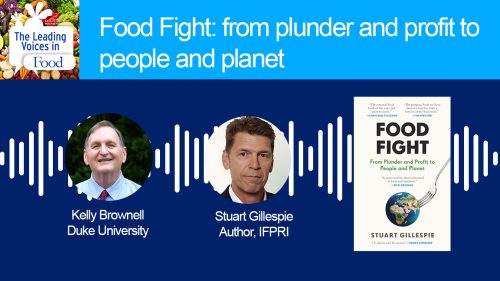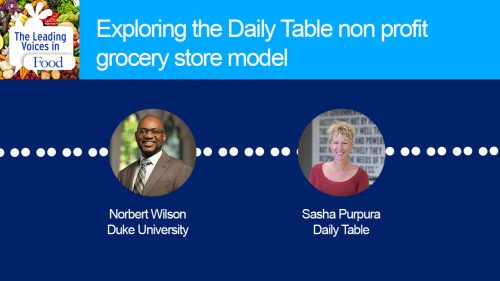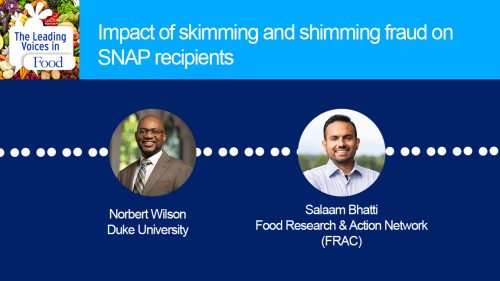E221: Understanding Poverty, Wellbeing, and Food Security for US Children
As the parent of a 12-year-old child, I know that raising a child is one of the most profound and rewarding experiences of a person’s life. It is also shockingly expensive. The high cost of child rearing is particularly difficult for families with limited resources. To help us think through this issue, it is my great pleasure to welcome a colleague here at Duke: Dr. Christina Gibson-Davis, Professor of Public Policy. Christina studies economic inequality, and particularly how it affects families with children.
Subscribe: Apple Podcasts | TuneIN | YouTube Music | SoundCloud | PocketCasts | Radio Public
Tags: Child Development & Nutrition | Diet & Nutrition | Equity, Race & Food Justice | Food Insecurity | Food Policy | School Meals | Social Safety Net & Food |

Christina M. Gibson-Davis is a professor at the Sanford School of Public Policy, Duke University, with a secondary appointment in sociology. Her research interests center around social and economic differences in family formation patterns. Her current research focuses on the how divergent patterns of family formation affect economic inequality.
Interview Summary
So, let’s do a bit of level setting. We often hear words like poverty and wellbeing. For our conversation today, what is poverty in the US and what do we mean by wellbeing?
In the US we have a definition of poverty that relies on a certain threshold. Every year the US government publishes a set of thresholds for families that say – if you are below this threshold, then you are poor. If you’re above this threshold, then you’re not poor. The thresholds are actually based on data from 1963, when the federal government decided it really needed a way to count the number of poor people in this country. Prior to 1963, we really didn’t have any way to do that. They looked at how much money people spent on food, and from that number, they derived these poverty thresholds. In 2022, the poverty threshold for a family of four, just to give your listeners some idea, was about $22,000. This means that if you earned $21,999, you were considered poor. But if you earned $22,001, you weren’t considered poor. That’s what I mean about the threshold and about falling either above or below that threshold in order to determine whether or not you’re poor.
Thank you, Christina, that’s really helpful. It is interesting that the measure of poverty really is centering on food, or at least traditionally has. We’ll get back to that in a moment. I want to go back to the question of wellbeing. Could you tell our listeners what you’re talking about when you talk about wellbeing?
When we talk about wellbeing, we mean things like how healthy kids are, or how they get along with peers, or how they do in school. Basically, it’s the way we measure how kids are functioning and whether they’re functioning to the best of their ability.
It sounds like it’s a broad notion that represents all the ways a child is a child, how they move in this world.
That’s exactly right. It’s going to cover a whole bunch of different areas. Everything from health and education to social relationships, to behavior, to delinquency, to how far they get in school. All of that goes into our definition of wellbeing.
Great. Thank you for that. I want to now focus a little bit more on children themselves. What does childhood poverty look like in the US?
We can have a technical definition of poverty, which is what I alluded to before, but really, that technical definition I don’t think paints a very illustrative portrait of what it looks like to be poor in the US. To be poor in the US as a kid means you’re growing up in an environment with very low levels of economic resources. You’re probably growing up in a household where you’re not sure if those economic resources are going to be enough for your family to maintain their home or pay their bills or get enough food. It’s a very sort of unstable situation for kids because they may be worried that their parents just don’t have enough money. It also sort of affects the kids’ outlooks. We know that poor kids tend to have sort of lower aspirations or hopes for the future. Not that they’re not hopeful, but they sort of also know that some of the things that they see may be depicted on TV that are open to other kids may not be an option for them; because they simply don’t see a path between where they are and how they’re going to get there.
That is actually pretty sobering. I’d like for you to explain something about households with children, and I noticed that a lot of our conversation is going to not focus on an individual child but about children in household context. So, how does poverty look different for households with children than households without children? Is there a difference?
Yes, there’s a difference in poverty rates. One of the things that distinguishes poverty in the United States relative to poverty in other Western or developed countries is that we have very, very high rates of child poverty. And one of the biggest risk factors, in fact, for being poor in the United States is being a kid. Kids tend to have higher poverty rates than other groups. Why is that? Well, obviously kids aren’t out making money. They’re relying on their parents for their financial wellbeing. But it really has to do with the public policy choices that we’ve made. Your listeners have probably heard of Social Security and Medicaid, and those are two huge programs that make huge differences in the lives of say, people over the age of 65. We really don’t have those kinds of corollaries for kids who are poor. And so, when you look at our policy priorities over the past, say half century, they’ve really been oriented more towards elderly people rather than kids. That’s just a policy choice that we have made.
Thank you for sharing that. I know in some of the work that you’ve done, you’ve also looked at these issues through an equity lens. Can you tell us a little bit more about the wealth inequalities of households with children. And how does that work shape how we should look at child wellbeing?
We’ve been talking up until this point primarily about income, which for most people is the money that they earn through their job. We think about income as the money that flows into your house. There’s also this really important concept, which is called wealth. Wealth is a household’s assets minus its debts. So, for most households, their primary asset is their house. And then they might have debts because they owe money on their house, or they have medical loans or education loans or things like that. So, wealth in the US is distributed far more unequally than income. In particular, the racial gaps in wealth are staggering. So, in the US, for every dollar of wealth that is held by a white family with children, a black family has less than 1 cent. Again, that’s a $1 to less than 1 cent ratio. When you have those kinds of inequities, it’s really hard for some families to make a difference in the lives of their kids. We know that wealth really helps, for example, for kids to go to college or to make a successful transition to young adulthood. And when we have these kinds of race-based inequities, it really hampers some of these kids from realizing their full potential.
I know we have a number of colleagues like Sandy Darity who work on this racial wealth gap. So, this is a critical topic that has influence on how we need to think about these issues. And that’s going to connect a topic that I have worked on, and that’s a great interest of our center. It’s the topic of food insecurity. Christina, can you help connect childhood poverty to food insecurity?
Food insecurity, as many of your listeners may know, is the ability to have enough food for a healthy, active lifestyle. Not surprisingly, being poor puts you at increased risk of being food insecure. It’s probably the predominant risk factor for being food insecure. The reason we care about that is because we know that food insecurity has all kinds of detrimental consequences for children. So, we were talking earlier about wellbeing covering a wide range of outcomes. Food insecurity really diminishes kids’ wellbeing in many of those areas that we were talking about. Kids who are food insecure are less healthy, they do less well in school, they may have more behavior problems. So, food insecurity is really something that can undermine the life chances of children.
I’m interested in now turning our focus to this issue of policy. We’re at a policy school and I would like for you to talk a bit about what our current policies are for addressing food insecurity.
For children, there are a number of food programs in the US. I would say the three most relevant ones for children are SNAP or Supplemental Nutrition Assistance Benefits, and WIC, Special Supplemental Nutrition Program for Women and Children. And then there is a free and reduced lunch program. Those programs together really try to address food insufficiency among children. The evidence suggests that they work pretty well. None of them by themselves are going to reduce all food insecurity among kids, but they definitely lessen the levels of food insecurity that kids experience.
There was an article in the “New York Times” about a year ago, the Fall of 2022, and it talked about readjustments to the measure of poverty, and they followed the family out of West Virginia. One of the things they did was they looked at the income that this family received, and it showed that 25% of the total, if you will, resources that came into this family were food-based programs, WIC, SNAP, and School Lunch Program. So, it’s an important part of how families with limited resources are able to meet some of their needs. I’m appreciative of you sharing that.
I think it’s absolutely vital, particularly when you think about families that may be living in places with really high rents. There’s been a lot of talk lately about how the cost of housing has gone up, and really these sources of food assistance that they get from the government is just absolutely critical to helping them meet the basic needs of their families. So absolutely, these food assistance programs are just a linchpin of how these families survive.
It’s interesting now that we’re in this moment of debating the Farm Bill, which is the federal program that supports SNAP, how it’s important for us to keep in mind that beneficiary of the SNAP program are children and children whose wellbeing can be affected by a program like this. I’m grateful for this conversation. Now, how effective are these policies at reducing food insecurity and addressing child wellbeing?
These programs work fairly well. They’re not, I would say, large enough or convey enough resources to eradicate levels of food insecurity. I think it’s also important for your listeners to know that there is no such thing as a federal food policy. So, we let states set the limits, for example, as to how much they’re going to spend on SNAP. This leads to large variations in like the SNAP limits. So, for example, if you live in New York, you get about $100 more in SNAP benefits than if you live in Oklahoma. So, what does this mean? It means that these programs are going to be more effective in some states than in others, simply because of the amount of resources that people may get based on where they live.
As we wrap up, I wonder if you have any other points of consideration about policy and how policies that we currently have can actually help us address child wellbeing more effectively.
One of the other things that distinguishes the US food policy landscape, if you will, is we also have a relatively large private sector. So, people may be familiar with food banks or other places where they distribute food. And, you know, that’s sort of the best and the worst that America has to offer, right? The best is that charitable organizations recognize the importance of providing food for people. And these organizations are very effective at providing meals and groceries, and it’s a really important source for these families. But I say it’s also the worst because there’s a giant need for these private sector places. And because the provision of these private sector food goods can vary depending on where you live or how much money the nonprofit organization has, it can be a very variable source of support for food. So, in some ways, our food policy landscape is kind of a crapshoot, if you will. And that I think that makes it hard for us really to get a handle on childhood food insecurity.
















